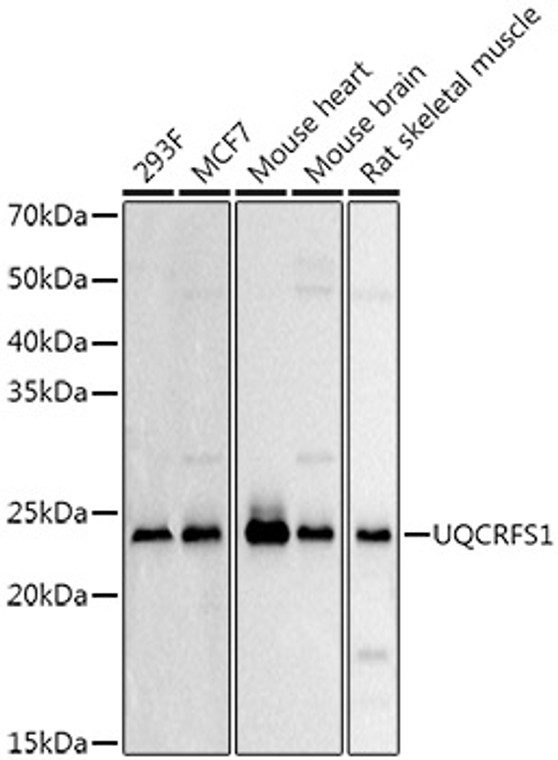| Host: |
Rabbit |
| Applications: |
WB/IHC |
| Reactivity: |
Human/Mouse/Rat |
| Note: |
STRICTLY FOR FURTHER SCIENTIFIC RESEARCH USE ONLY (RUO). MUST NOT TO BE USED IN DIAGNOSTIC OR THERAPEUTIC APPLICATIONS. |
| Short Description: |
Rabbit polyclonal antibody anti-UQCRFS1 (141-274) is suitable for use in Western Blot and Immunohistochemistry research applications. |
| Clonality: |
Polyclonal |
| Conjugation: |
Unconjugated |
| Isotype: |
IgG |
| Formulation: |
PBS with 0.05% Proclin300, 50% Glycerol, pH7.3. |
| Purification: |
Affinity purification |
| Dilution Range: |
WB 1:100-1:500IHC-P 1:50-1:200 |
| Storage Instruction: |
Store at-20°C for up to 1 year from the date of receipt, and avoid repeat freeze-thaw cycles. |
| Gene Symbol: |
UQCRFS1 |
| Gene ID: |
7386 |
| Uniprot ID: |
UCRI_HUMAN |
| Immunogen Region: |
141-274 |
| Immunogen: |
Recombinant fusion protein containing a sequence corresponding to amino acids 141-274 of human UQCRFS1 (NP_005994.2). |
| Immunogen Sequence: |
SASADVLALAKIEIKLSDIP EGKNMAFKWRGKPLFVRHRT QKEIEQEAAVELSQLRDPQH DLDRVKKPEWVILIGVCTHL GCVPIANAGDFGGYYCPCHG SHYDASGRIRLGPAPLNLEV PTYEFTSDDMVIVG |
| Post Translational Modifications | Proteolytic processing is necessary for the correct insertion of UQCRFS1 in the complex III dimer. Several fragments are generated during UQCRFS1 insertion, most probably due to the endogenous matrix-processing peptidase (MPP) activity of the 2 core protein subunits UQCRC1/QCR1 and UQCRC2/QCR2, which are homologous to the 2 mitochondrial-processing peptidase (MPP) subunits beta-MPP and alpha-MPP respectively. The action of the protease is also necessary for the clearance of the UQCRFS1 fragments. |
| Function | Cytochrome b-c1 complex subunit Rieske, mitochondrial: Component of the ubiquinol-cytochrome c oxidoreductase, a multisubunit transmembrane complex that is part of the mitochondrial electron transport chain which drives oxidative phosphorylation. The respiratory chain contains 3 multisubunit complexes succinate dehydrogenase (complex II, CII), ubiquinol-cytochrome c oxidoreductase (cytochrome b-c1 complex, complex III, CIII) and cytochrome c oxidase (complex IV, CIV), that cooperate to transfer electrons derived from NADH and succinate to molecular oxygen, creating an electrochemical gradient over the inner membrane that drives transmembrane transport and the ATP synthase. The cytochrome b-c1 complex catalyzes electron transfer from ubiquinol to cytochrome c, linking this redox reaction to translocation of protons across the mitochondrial inner membrane, with protons being carried across the membrane as hydrogens on the quinol. In the process called Q cycle, 2 protons are consumed from the matrix, 4 protons are released into the intermembrane space and 2 electrons are passed to cytochrome c. The Rieske protein is a catalytic core subunit containing a 2Fe-2S iron-sulfur cluster. It cycles between 2 conformational states during catalysis to transfer electrons from the quinol bound in the Q(0) site in cytochrome b to cytochrome c1. Incorporation of UQCRFS1 is the penultimate step in complex III assembly. Cytochrome b-c1 complex subunit 9: Component of the ubiquinol-cytochrome c oxidoreductase (cytochrome b-c1 complex, complex III, CIII). UQCRFS1 undergoes proteolytic processing once it is incorporated in the complex III dimer. One of the fragments, called subunit 9, corresponds to its mitochondrial targeting sequence (MTS). The proteolytic processing is necessary for the correct insertion of UQCRFS1 in the complex III dimer, but the persistence of UQCRFS1-derived fragments may prevent newly imported UQCRFS1 to be processed and assembled into complex III and is detrimental for the complex III structure and function. |
| Protein Name | Cytochrome B-C1 Complex Subunit Rieske - MitochondrialComplex Iii Subunit 5Cytochrome B-C1 Complex Subunit 5Rieske Iron-Sulfur ProteinRispRieske Protein Uqcrfs1Ubiquinol-Cytochrome C Reductase Iron-Sulfur Subunit Cleaved Into - Cytochrome B-C1 Complex Subunit 9Su9Subunit 98 Kda Subunit 9Complex Iii Subunit IxCytochrome B-C1 Complex Subunit 11Uqcrfs1 Mitochondrial Targeting SequenceUqcrfs1 MtsUbiquinol-Cytochrome C Reductase 8 Kda Protein |
| Database Links | Reactome: R-HSA-611105 |
| Cellular Localisation | Mitochondrion Inner MembraneSingle-Pass Membrane Protein |
| Alternative Antibody Names | Anti-Cytochrome B-C1 Complex Subunit Rieske - Mitochondrial antibodyAnti-Complex Iii Subunit 5 antibodyAnti-Cytochrome B-C1 Complex Subunit 5 antibodyAnti-Rieske Iron-Sulfur Protein antibodyAnti-Risp antibodyAnti-Rieske Protein Uqcrfs1 antibodyAnti-Ubiquinol-Cytochrome C Reductase Iron-Sulfur Subunit Cleaved Into - Cytochrome B-C1 Complex Subunit 9 antibodyAnti-Su9 antibodyAnti-Subunit 9 antibodyAnti-8 Kda Subunit 9 antibodyAnti-Complex Iii Subunit Ix antibodyAnti-Cytochrome B-C1 Complex Subunit 11 antibodyAnti-Uqcrfs1 Mitochondrial Targeting Sequence antibodyAnti-Uqcrfs1 Mts antibodyAnti-Ubiquinol-Cytochrome C Reductase 8 Kda Protein antibodyAnti-UQCRFS1 antibody |
Information sourced from Uniprot.org
12 months for antibodies. 6 months for ELISA Kits. Please see website T&Cs for further guidance








